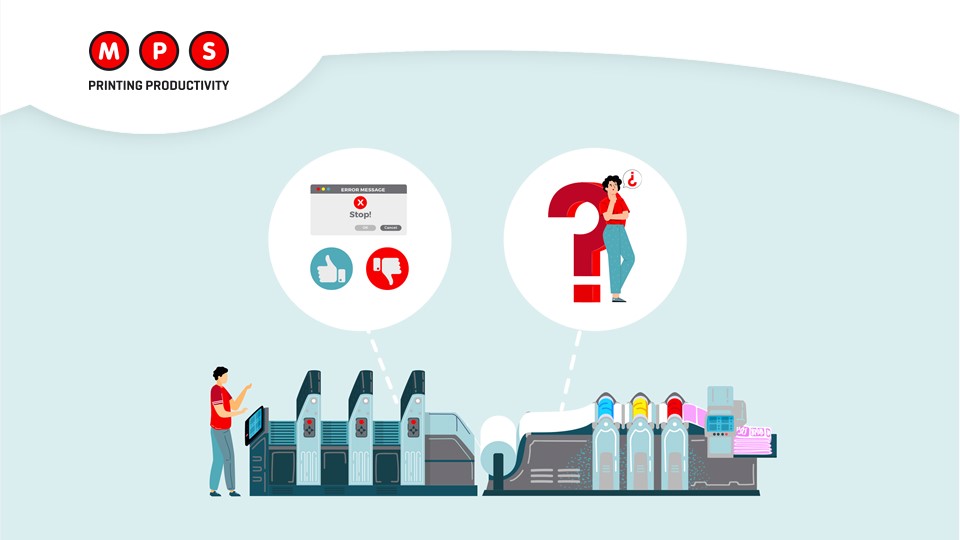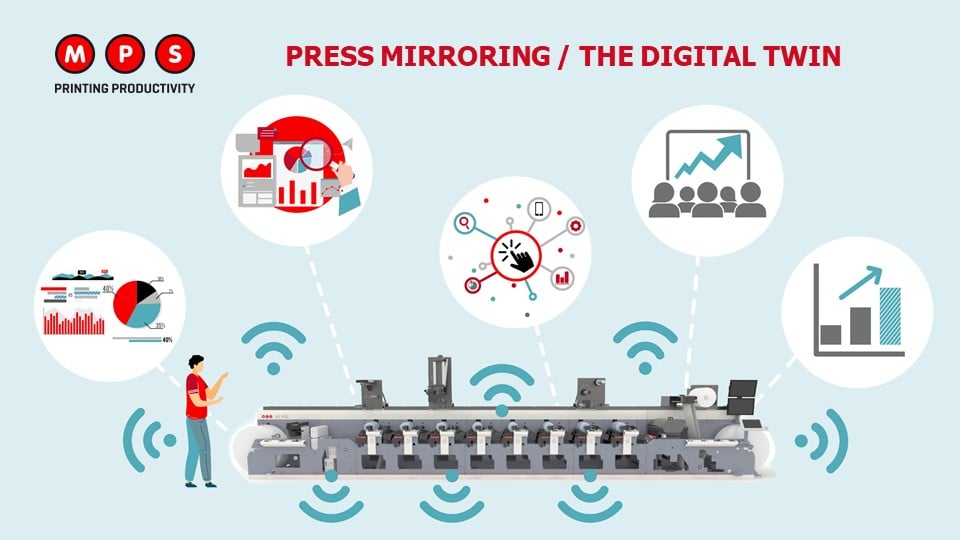 Here’s a Formula One (F1) Mission Control room.
Here’s a Formula One (F1) Mission Control room.
Every F1 team has this dedicated operations room filled with monitors where the entire behaviour of their race cars is tracked.
They know everything about their cars, as a huge amount of information is measured with sensors placed throughout every F1 car. Data is measured and processed about the engine, wheels, tires, and factors such as brake temperatures and wear, tire pressures, G-Forces, and vibration.
Information from this data is not only used to win the current race, but is also analyzed and used to improve the cars and win future races.
Switching gears to the world of label printing
Let’s start with the printing press.
It’s a machine that can cost between EUR 300,000 and EUR 3million. And the information we get from this machine is typically basic: speed, mechanical or electrical errors, sometimes pressure information (anilox vs. plate and impress roller vs plate cylinder) plus registration information.
You don’t really get information as to how the machine peforms such as how long it takes to set up the unwinder, waste, uptime, downtime, and speed over a day or week.
Of course, you can ask your operators to type or scan actions they have done. But this is certainly not real-time, nor hundreds of measurements per minute, and probably not that accurate.

Big expensive black box
Many print companies use workflow automation systems like CERM, Label Traxx or HYBRID Software. These systems do a great job focusing on job data and prepress information. But they can’t look inside and know what’s happening with the press - only what’s going on around it.
So basically, we’re dealing with a big expensive black box.
This is quite strange if you think about it, because this possibly million-dollar machine is paying your salaries. Shouldn’t you know everything about the press and ensure it runs as efficiently as possible?
If you look at other industries, many are much further ahead than the label printing industry. Consider automobiles, especially the F1 but normal passenger cars too – think about the development of self-driving cars and trucks. The airline industry – a plane can automatically ascend and descend without any pilot interference.
Why it’s important to know how your press is performing
These high cost label printing machines are for a large part of the day not running. In fact, from what we’ve seen, many printers aren’t running their machines 70% of the time. This is a significant amount of downtime.
Obviously, to earn back your machine investment, you must run it as much as possible to maximize the uptime.
Another point is your machine might be running, but you don’t know how efficiently.
For example, you don’t know exactly how long it took to set up the unwinder, how long it took to get into registration and the way the registration button was pressed to get into registration. Actually, you have very little idea at all how the machine is run. You might have some basic input done manually by the operator.
Certainly no actual, streaming, continuous, dynamic data.
This is interesting, as companies are very particular during the selection of their new press. Which press gives the fastest set up time and lowest waste? But after installation of that fancy press, they can’t really determine how efficiently the machine is being run.
What we discovered is the biggest gain in efficiency can be generated by analysing how the machine is operated to reduce bottlenecks and weak points. Improvements that can be made is not just a minute here and there. On the contrary: savings are up to hours per day.
That is incredibly good news, as these hours can be used instead to print labels and earn extra profit!
Make your printing press on par with the F1 car
By placing hundreds of sensors in the press, continuous streaming data can be collected and analysed to understand bottlenecks, benchmark, and to continuously improve the press performance.
We call this press mirroring: essentially creating a digital twin, together with performance reporting.

With the ability to analyze streaming data, you can get real-time insights to understand exactly what’s happening at any given point in time with your press, in great detail. Not just the 10 to 20 scans that the operators are making during the run of the job at their own pace.
Having a digital twin with streaming dynamic data enables better decision-making as it gives you exact details to improve the overall print operation.
Real-time information at your fingertips
Analytics from streaming data is accessible in real-time, online on a dashboard. You can access this important information from anywhere you are in the world, provided you have internet access. More detailed analysis can also be made by zooming in on specific details.
This is particularly important. For example, you don’t have to wait to receive reports by email. Reports are available online and can be accessed, reviewed, and re-reviewed at any time.
With analytics from streaming data, you’re more agile and responsive to the realities of what’s happening in your label print operation. Streaming analytics allows you to be proactive with real-time processing and decision making instead of being reactive.
You’ll be faster than your competitor who does not use this valuable resource and you’ll gain a lot of extra capacity due to the continuous implementation of best practices, reductions of errors and downtimes. All at a much earlier stage.
Where to start
How to implement streaming data? By placing hundreds of sensors in your printing press, equipping every press with a server, and having software to compile and analyse this large data input.
The type of reports can be of performance of one machine, comparing different machines at one company, or benchmarking with industry leaders.

You can group performance such as: Best in Class, Better than Average, and Less than Average.
With average users, you can discuss what they must do in order to move to the best in class. Is it feasible? Is more training needed?
The whole purpose of this exercise is to identify areas of improvements and subsequently a to do list to make improvements.
What are the benefits of press mirroring and performance reporting?
In a nutshell, they are:
- Continuous, real-time transparency in production
- Benchmarking with industry leaders
- Identifying bottlenecks, gaps, worst and best practices
- Decisions on productivity improvements based on Accurate data.
All of this leads to higher productivity and profit! And it will be a continuous process.
Operations management will now have a super powerful tool to increase uptime and efficiency of production. As a result, net capacity will increase to run more jobs and generate more income.
The time is now
This technology is not future music. It’s all available today. The sensor technology – the IoT or so called Fourth Industrial Revolution – is a real revolution.
At MPS, all our new presses are equipped with a server. We can collect data from all machines delivered since the beginning of this year (2020).
The technology gives you information and knowledge about your operation. We can even give you reports about what we - with a team of experts - think and should happen to improve your operation.
However, this technology, analytics, and performance reports alone will not bring success. You must have the willingness to analyze and interpret the data, and implement actions for improvements.

MPS works closely with partners for connectivity such as UV, anilox roller, and inking systems suppliers. Technically, interconnectivity is possible with all parties.
This development won’t stop: it will only grow faster, especially with 5G being implemented soon which will enable even quicker data transfers.
Learn more about what Big Data means to the Label Printing Industry
Are you ready for your F1 Mission Control room?
It’s important for every label printer to understand these developments in connectivity.
What’s press mirroring? How can performance reporting help me? What investments should I make to implement this technology? Does it already fit my organization, or do I need to first change processes?
Real-time production performance data can be used to give management an immediate perspective on how business is developing. Successful companies will integrate these streaming analytics to move from a reactive to a more proactive approach for achieving operations excellence.
The added value is in the possibilities offered by the data. The knowledge it gives you about weak and strong points in your production enables you to take the right actions for continuous improvements: to lower your cost of operation, increase your capacity, and increase your profits.
One thing is certain: connectivity will disrupt and transform label print production. It’s wise to make small steps in implementing these technologies and have processes in your organization for continuous improvements.
Questions about connectivity and how we can help you get started? Get in touch.